I have a strange and troubled time with London east of the city. Inspired by Iain Sinclair I've wandered some fairly strange paths, and visited places I'd never dreamed of heading for in search of the curious corners of the city. But more than anywhere, wandering here makes me feel something separate from the City - an outcast, albeit quite often in a sea of other temporary citizens. Here, especially, authenticity is brought into sharp focus. With so much written and spoken about the legends of the territory, from ancient plague-grounds to modern murder myths, its hard not to feel like a tourist. The grim reality is that the Hoxton art student posing his way along the queue at the Beigel Bake, or the carefully designed media type lurking around 93 Feet East is more at home here than I will ever be. For someone who tries hard to read the City unconditionally and walks with a degree of perhaps pathetic reverence, this is a crushing defeat of style over content.
A bit of recent reading though has reassured me that this area is far from out-of-bounds to the outsider, and reminded me that these boundary lands have been contested spaces and seen multitudes of populations share the streets and alleyways over centuries of change and redefinition. So today's walk, tagged onto a trip further east into incongruous rural Essex, was an attempt to reclaim my little bit of Spitalfields and Shoreditch and to walk shoulder to shoulder with everyone else who didn't really belong but had gravitated here for sometimes unfathomable reasons.
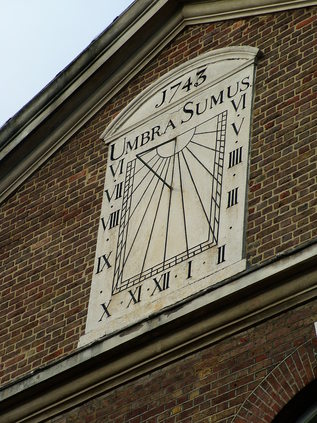
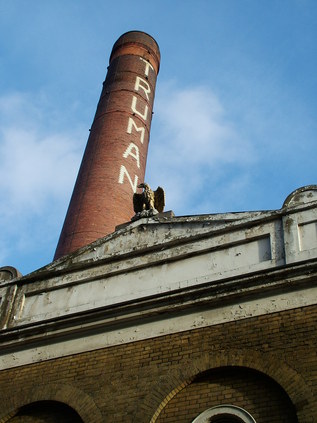
Beyond Fournier Street, with its painstaking heritage treatment measured by balooning property prices, Brick Lane changes. The curry houses dwindle and the former Black Eagle Brewery begins to dominate both sides of the street in a warm glow of yellow brick and shadow. Here in Dray Walk are the painfully hip bars and shops which are perhaps where I am most truly out of place. I slip apologetically into Rough Trade East in the hope of finding a fairly obscure American release I've been looking for. It's hard to understand the store - all space, pastries and sofas - not like the happy clutter of their West End locations. I slip out, negotiating the crowds of in some instances genuinely beautiful people, and regain the main line of the lane. Here, where the railway crossed before the bridge was dismantled, I head into Pedley Street to find the remains of Shoreditch Station. On my previous foray, this is where I bailed out, not fully grasping my bearings. Closed for a year or more, the station is decaying. Beside it, a glimpse over the wall allows sight of the ancient and long abandoned Bishopsgate Station platforms deep below, and which my train into Liverpool Street had passed just a little while before. The cutting in which the East London Line ran now accommodates a sweeping concrete bridge taking the gradually forming extension high over the Great Eastern Lines. I pass under this, through a narrow tunnel in the scaffolding and hoardings which divides the two sections of the lane almost perfectly. Tiny, expensive shops full of intricate, innovative and artistic goods sit comfortably beside the Beigel Bake. Young professional families stroll by, making the most of a cold, bright winter morning. What little of the market is out today straggles along to the Cheshire Street junction before petering out entirely as I turn west into Bethnal Green Road. The sign for Shoreditch Station twisted back on itself, perhaps not accidentally pointing to the vast concrete box bordering Sclater Street which will eventually be part of the new Shoreditch High Street station.
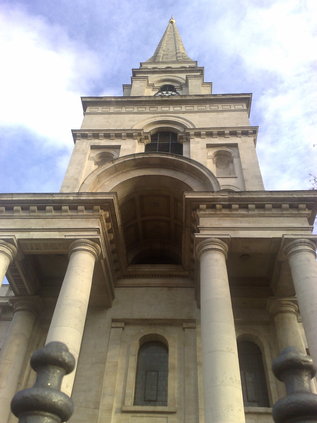
Perhaps we are all shadows?
The strange pattern of streets between Grays Inn Road and Mabledon Place has always intrigued me. Having based myself in Bloomsbury on many of my visits, this strange hinterland bordered by Euston Road to the north and Bernard Street to the south has been frequently explored. Little corner pubs and newsagents have become strangely amplified landmarks in this corner of St Pancras which has almost become home. Not quite West End and not quite city, it seems that the waves of commerce and redevelopment never quite reach the centre of this quiet corner of London.
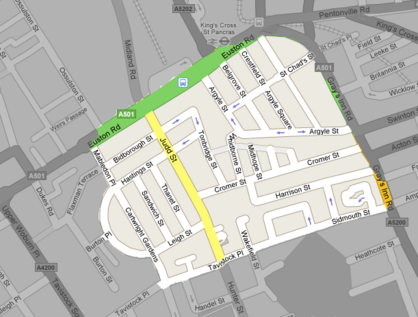
Visiting for the first time in a long time, I found myself staying in the northern corner of the territory, not far from Kings Cross. I'm nervous about my accommodation, but needlessly - it's basic, clean and secure which is all I need for the purposes of my stay. Wandering out to Brunswick Square to shop, I take a long circuit through busy Marchmont Street. Freshman students, not yet quite formed and still wide-eyed in the tumult of post-Office drinkers pass me. They're new here and still apologise quietly for brushing past me. I find Brunswick Square transformed - the strangest of Camden's housing development once sat atop a tired shopping arcade, mostly vacant except for a supermarket and an excellent used book store. Now, the supermarket is an upmarket Waitrose and the square is filled with evening life - the bookstore pushed underground on the fringe of the development. Restaurants and bars fill the once empty shopfronts. Things are changing, Bloomsbury is buzzing again.
Heading back into the dense net of streets north of Coram's fields, all is quiet. The largely residential area is dark, and only the tree-lined and paved Cromer Street with its closed and shuttered shops indicates the strange village I stumbled across a few years back on a walk out to Kings Cross from my Bloomsbury base. Swinging north, the great tower of St Pancras Station looms, scaffolded and ominous above the glassy new station. I want to understand this curious corner - a space that is folded into the map by passing tourists, not seen, it's dimensions not sensed from passing by on the high road. However, I think to understand this quarter one needs to live here in the shadow of the city and it's western neighbour.
I was determined to get to the LAMAS Local History Conference this year, after dropping out at the last minute a year ago due to being unwell. Today's trip presented it's own challenges, being the first day of the line closure which will dog the next month (and which I seem to mention in every post here lately!). Up early and onto the replacement bus which actually arrived as planned and got us to Taunton station quickly and on time. I suspect it all worked well because it was 06:01 and there wasn't much that can go wrong with the first bus of the day on relatively quiet roads. Onto the 07:10 to Paddington which was surprisingly busy. Had a sleepy journey up to London, and amazingly my fairly tight schedule once I'd arrived all worked out. I was in my chosen spot in the Museum of London lecture theatre a little before 10am, ready for the day's events.
As ever I was one of the younger audience members, and chatting to a few of the very active local historians it became clear that this was very much an interest which grew after retirement. They tend to have very specific interests in their own immediate environs, and seem to view any discussion of space and our relationship with it as 'post-modern bollocks' as one spirited old chap told me! After the introductions Jeremy Ashbee from English Heritage gave an interesting insight into the daily life of a Royal palace, in particular The Tower of London. His research indicates that many monarchs spent incredibly short periods at the palace, with Henry III managing only 38 weeks in 52 years. Outside these periods (for which the accounts indicate the household were often embarrassingly unprepared) the Tower enjoyed a multitude of uses and records indicate that even the King's own chambers were subject to alteration to confine a particularly slippery prisoner. Detailed, and sympathetically presented research is always a pleasure to listen to, and Jeremy clearly knew his topic.
From the sphere of Royalty we moved to the Ecclesiastical with Dr Vanessa Harding's quick sweep across the lost landscape of religious houses in London. In order to set the scene she gave a quick and useful run-down of the orders and sects operating in the City and their lineage. I confess a degree of bewilderment at the range of twists and turns Christianity appears to have taken during the Middle Ages, but suffice to say it appears you couldn't move for monks! Dr Harding linked her discussion of lost places back the the modern city which brought to life a complex and informative paper. I was amused by the 'Da Vinci Code' inspired gasps when the Knights Templar entered the discussion!
Next up was Hermione Hobhouse standing in at short notice for a speaker who couldn't attend. I'm not familiar with her Lost London (1971) but via a wide variety of slides, some much missed buildings and scenes were revisited. A quick reappraisal of the literature of lost London also failed to take into account William Kent's post-war catalogue 'The Lost Treasures of London' and the London Topographical Society's major publication of the LCC Bomb Damage Maps. Overall, I was disappointed by the conservative vision of a London lost because of immigration or diversification. It is a grave error to omit the huge influence this has had on London's growth and development from any account of the city. Looking backwards doesn't need to mean thinking backwards.
A swift lunch break in surprising sunshine, then back to see Nicholas Barton, author of Lost Rivers of London which is perhaps the book which turned my interest in the city from one purely relating to transport history into something rather more all-encompassing. A fascinating work which even nods towards the modern exploration of the 'sick city' in its brief acknowledgment of the epidemiology of the buried rivers. The talk ran through the book as published, with a few updated anecdotes - but it remained as fresh and engaging as the first read.
So, a hard act to follow - and for me another winner with Jim Connor on Disused Underground Stations. I had the feeling that Jim could have continued for hours, with engaging discussion and some informative pictorial evidence of the former stations. Jim ran out of time purely because of his encyclopaedic knowledge of the folklore and urban mythology of the Underground, which he delighted in sharing. Again, amazed at the fairly low level of awareness as evidenced by some of the gasps of surprise emitted by the audience. To finish things off, a brave choice - Kelvin MacDonald of the Royal Town Planning Institute on the Abercrombie Plan for London. As local historians and planners are almost always at odds, this was an interesting occasion. Kelvin's talk was intriguing. His take on Abercrombie's work was critical but he clearly admired the vision and bravery of the plan. His time ran out just around the point he was discussing the plan's legacy. I'd like to have seen him speak more on the remains of the halfhearted attempt to construct the Motorway Box, and it's effect on communities - particularly around the M11 interchange in Hackney for example. Kelvin's paper reminded us all that London moves onward - and you can either sit with the disgruntled country dwellers up for the weekend to hear some talks, or engage in the movement. The key is never to act surprised if you end up somewhere unexpected.
Once again, left partly inspired and partly dejected by the LAMAS experience. A swift dash across the city to Paddington, and an oddly convoluted route back to Taunton.
Up early, a quick but fairly sizable breakfast, and out into the cool clear morning. This is the first time for a long time that I'd been in London purely with the purpose of walking. Being much less fit that before, and having very little energy after the last few weeks, I was a little apprehensive. I hadn't planned a great deal at all, but with books and such loaded into my bag I planned to see where things took me.
The first target was New River Head where Myddleton's artificial watercourse reached its goal, not far from the mythical Penton Mound. Started with a gentle walk along Doughty Street and skirted two sides of Mount Pleasant - one of which I'd not passed along before, a tumbledown street of properties commandeered by the Post Office to store vehicles and trolleys or just simply buldozed for car parking. The street was called Phoenix Place, but was clearly not in any way in the ascendent. Along Exmouth Market, watching the street wake up and the bleary-eyed post-coital couples looking for excuses to part in the coffee shops. Soon found myself on Amwell Street, named for the springs at the other end of the river.
It appeared someone had forgotten to tell Thames Water that they'd be taking part in the event, because nothing much was 'open' at New River Head. Found my way into a small commemorative garden at the rear of the site where a number of other disappointed visitors were milling around. A resident from nearby flats involved herself, and gave a shaky and fairly inaccurate history lecture to all present. Throughout this she referred to the river sneeringly as 'it', like there was some personal grudge. I left to explore the rest of the area, and to attempt entry to the main office. As I dithered on the steps, the same native appeared and urged me to go in. I did, if only to escape this increasingly sinister presence. Directed to the Oak Room, I spent a few moments examining its impressive but somehow incongruous opulence before leaving. As I passed the security desk, the native was leaning over, giving the security guard a good dressing down. I slunk by, and out into the street.
My next location was the Grand Priory Church of the Order of St. John in St John Square. I made good speed through Clerkenwell and arrived just in time for opening. Again, the staff didn't. Waited with an increasing crowd of Open House guide toting people in various degrees of leisurewear. There was much talk of 'doing' this building or 'ticking off' that. The whole event was starting to sour for me. It was now a game of architectural bingo which didn't sit well with my mythologising of the city at all. Almost left, but the doors finally opened, and I'm pleased because otherwise I'd have missed an interesting and calming oasis, with an ancient crypt. Most interesting discovery though was the line of housing declaring 'ancient lights' rights to unimpeded window views which overlooked the cloister.

Here I took a coffee break. My plan had been to head south and into the City, checking out whichever churches and Livery Halls crossed my path. I'd likely find myself in some old haunts, but this only added to the fun. However, my little elitist hissy-fit at the Grand Priory Church was still with me. A change of plan was in order. So I set off, via Smithfield and through the gatehouse of St Bartholomew the Great - oldest of the city churches in many respects, dating from 1123 or thereabouts. The interior was quiet, reeking of fresh flowers and the dust of replacement floorboards.
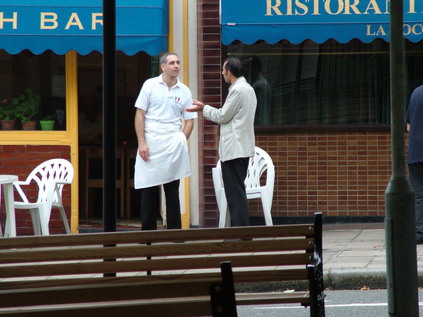
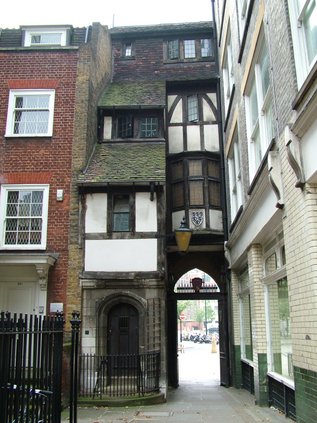
So I didn't. Having taken on board refreshments I struck out east. Over Bishopsgate and along beloved Brushfield Street with Christ Church, Spitalfields towering over more recent monstrosities. I thanked it's cold white stone for still being there, year after year. Now into Fournier Street, and then Princelet Street. No need to join the queue to visit No.19 again, but I paid my respects to Rodinsky, the mysterious walker of London pathways who had lived above. I'm certain his legend still brings these crowds, who are just as disappointed as I that the room is not open. But for me, the starry ceiling of the hidden synagogue was enough to astound and startle. Further east, deeper into Spitalfields. Over Brick Lane and into Greatorex Street. Sudden calm. Happy family groups walking to the market, to pray or just to be out on a fine warm day. The streets radiate heat back at me, and I realise for the first time that my feet hurt.
Rather unexpectedly I'm cast into the roaring tide of Whitechapel Road. Buffetted around the pavement at first, before I find the rhythm of the crowd and dodge my way further east. I'm tempted by Durward Street, just because I'm sure I once read of its association with the Ripper myth - perhaps as the only street not to be renamed after the events? I'm not a great student of the Ripper cases, but the idea of continuity and resistance in the street name not being changed appeals to me. In any case, Durward Street is now a featureless minor road skirting a new housing scheme and with a huge fitness centre along much of it's length. The entire opposite side is taken up by the Underground lines heading into Whitechapel Station. Back in the melee I moved fairly freely between market stalls and street furniture, desperate to cross to examine the rather bland edifice of the Royal London Hospital. Having recently read Iain Sinclair's 'Radon Daughters' I was curious. Clearly it is vast, labyrinthine and disconcertingly old and tumbledown. Its also a hospital, which for me creates its own difficult resonance - I used to suffer a terrible phobia of the places, and only a career on the very fringes of the NHS freed me from it. I don't quite manage to link into Sinclair's more sinister or political views, despite the crowd of Special Brew connoisseurs populating the steps. The site of the mound or of the original White Chapel now hosts a tangle of undergrowth and several portakabins, none of which appear to be in regular use. I swing south again into New Road. More hospital, it's straggling departments and impedimentia reaching far along this rather dull and menacing street.
I'm out on a limb now, geographically and culturally isolated. I continue south knowing that once over the grim crossing of Commercial Road I'll soon find the twin eastward ways of Cable Street and Ratcliff Highway - both have their shameful pasts and billboard mounted futures. On the corner of Commercial Road, an elderly man with his Open House guide is being directed east by a local. I'm pleased to see people heading out here to the forlorn churches and industrial heritage of the east. I head part by instinct and part by compulsion to St George-in-the-East. I've not been here since 2004, despite a walk almost getting me here once. The church stands white and imposing in a deteriorating scene of chaos. Monuments decked in graffiti, where angels have acquired felt-tip genitalia. The entire place teems with litter and drowsy wasps. I make a phonecall from here, because at least it's quiet and isolated. I feel almost comfortable, and its hard to move on when the time comes. Onto the Highway, and a brief detour through singularly unimpressive Swedenborg Gardens - again a misread literary location. I turn north again onto Cable Street and Royal Mint Street, watching the Docklands Light Railway get swallowed by the earth before plunging back into the swell of the City.
At The Monument I once again pause to regroup. My feet are disintegrating and its a fair way back, even by train. I develop a strange urge to complete my proposed St George-in-the-East to St George Bloomsbury walk, which didn't quite make it. So, now hobbling on a blister I strike out - Cornhill, Holborn - passing the more traditional sights as quickly as my legs can now work. Beside me, pensioners dawdle and eye their guidebooks. Soon enough I find myself at the southern end of Southampton Row. Now barely lifting my feet to walk, I make a frenzied skirt of the Museum area. I can't find St George Bloomsbury. More accurate, I know where to find it, but I'd underestimated how hard it would be to get there. Dejected, but still exhilarated from my 'walking off the map' I drag my bleeding stumps home rather than trying to find a disappearing church, coincidentally passing the Swedenborg Society on route. Food, beer and sleep beckon - but a pair of new feet would do nicely. Despite my hunger, thirst and pain I'm secretly very happy with my wander away from the Open Sites. Perhaps the occasion means that prying eyes and CCTV are looking elsewhere, so Open House really does provide me with the freedom to wander the city? In which case, I'll see you next year...
Lost::MikeGTN
I've had a home on the web for more years than I care to remember, and a few kind souls persuade me it's worth persisting with keeping it updated. This current incarnation of the site is centred around the blog posts which began back in 1999 as 'the daylog' and continued through my travels and tribulations during the following years.
I don't get out and about nearly as much these days, but I do try to record significant events and trips for posterity. You may also have arrived here by following the trail to my former music blog Songs Heard On Fast Trains. That content is preserved here too.





